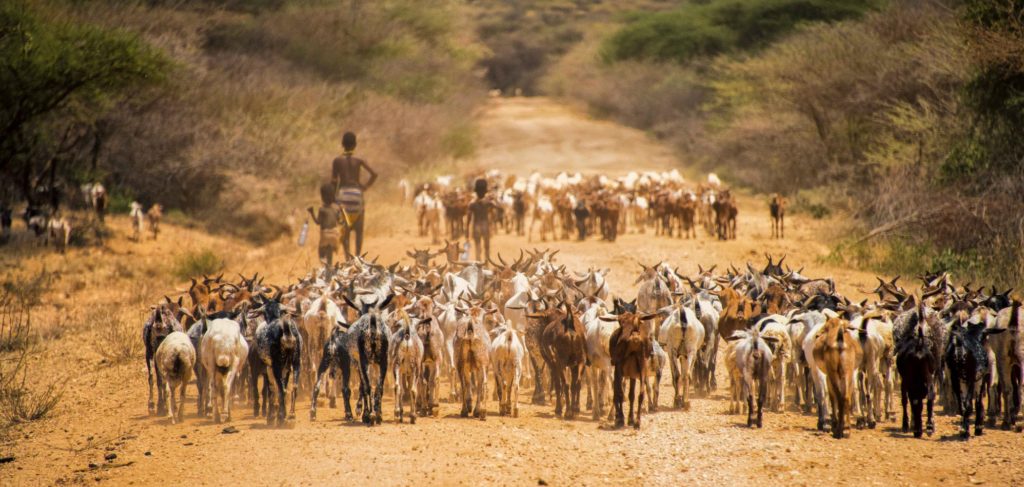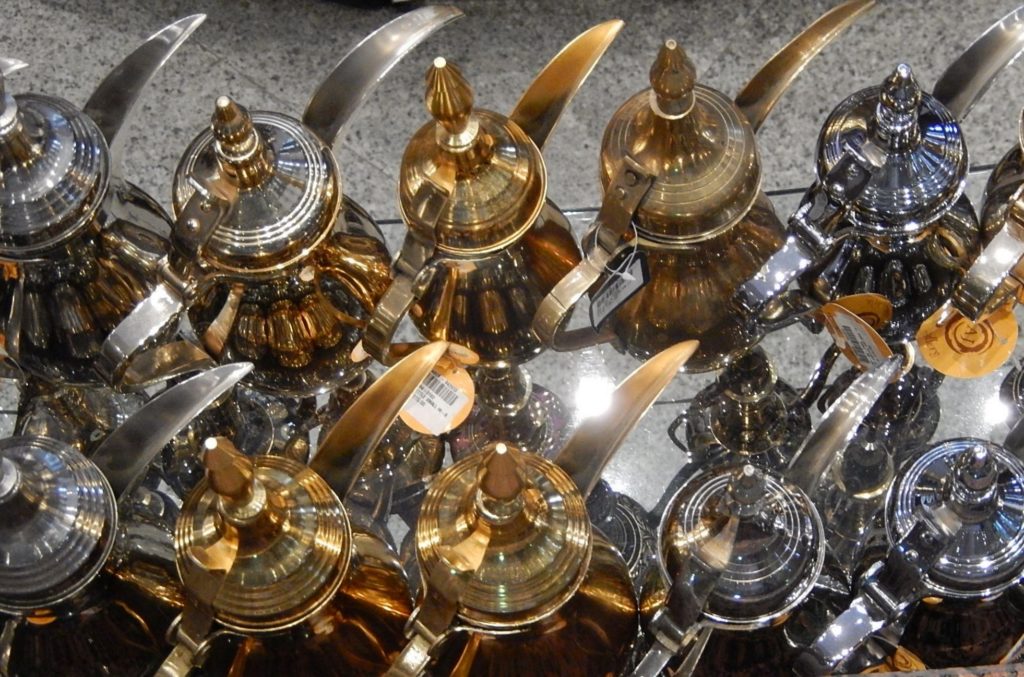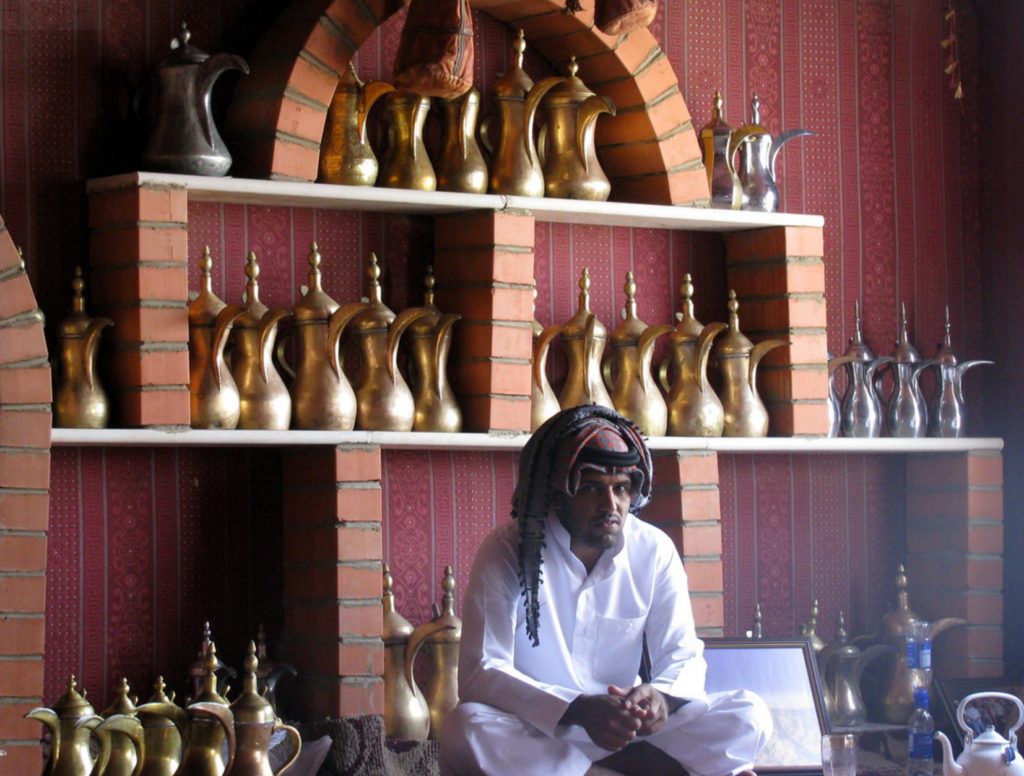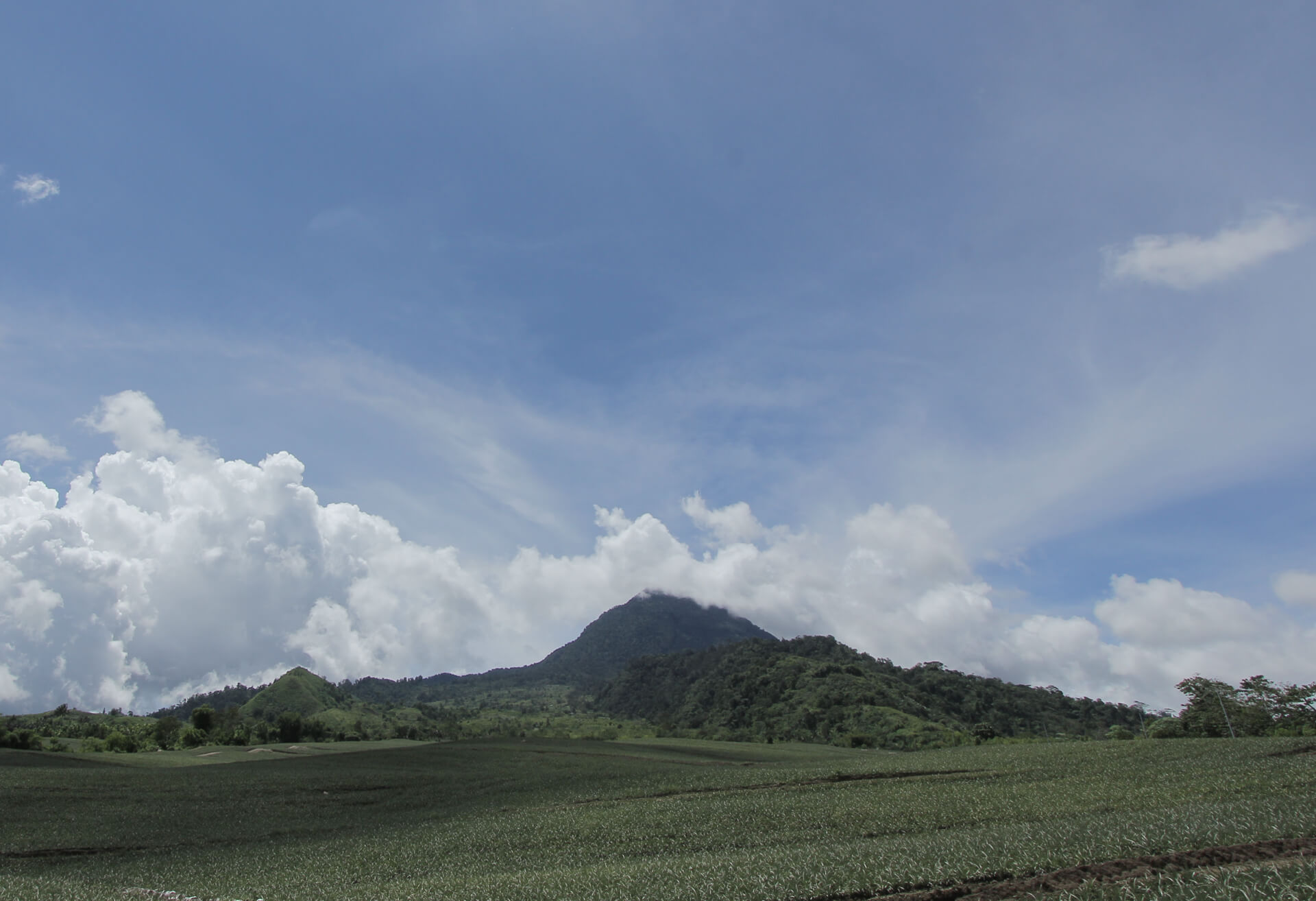Coffee Culture and History in the Middle East
Coffee is the second most traded commodity in the world. It is estimated that around 2.25 billion cups of coffee are consumed every day. While coffee may have been around for more than a thousand years, it has only become ubiquitous in its use in the last few centuries.
The Creation of Coffee
According to legend, an Ethiopian goat herder was minding his herbs when he noticed the goats suddenly becoming full of energy. They had just eaten the red fruit of a coffee shrub, so the goat herder tried the beans as well. Before long, others were trying the fruit for its natural stimulant properties.

Traditional Goat Herders in Ethiopia. Photograph under CC by Rod Waddington.
While this may just a legend, it is one of the few origin stories for modern coffee. Before it was roasted and consumed as a drink, coffee was blended with animal fat to make a snack bar. In about the year 1000, a drink was made using the entire fruit, beans, and hull. By the 1200s, people finally began to roast the bean, turning it into a version of the modern drink we love today.
Learn more about the history of coffee here
The History of Coffee in the Middle East
For people to enjoy a warm cup of middle eastern coffee like you do today, a few transformations had to first take place. The 1200s were the turning point for the modern beverage. At this time, the Muslim community in Arabia began brewing coffee for its stimulant powers. At the time, the drink was used to keep them awake for extremely long prayer sessions. The beans were parched and boiled to make a drink.
While the Middle East began blending coffee beverages centuries ago, the rest of the world did not get coffee until the 1600s. Until then, coffee was only consumed within Arabia. According to tradition, there was not a single coffee plant outside of Africa or Arabia until the 1600s. At this time, an Indian pilgrim known as Baba Budan [https://en.wikipedia.org/wiki/Baba_Budan] left Mocha with seven beans having fallen in love with the beverage during a pilgrimage to Mecca. These beans were the start of Europe’s fascination with coffee.
The first European-owned coffee production was started in the 17th century by the Dutch in Sri Lanka. Across the world, the French were growing coffee in the Caribbean. Soon, the Portuguese began producing coffee in Brazil, while the Spanish used Central America for their coffee estates.
As the popularity of coffee spread, coffee houses began springing up everywhere in Europe. Italy and France led the way, but the rest of the continent soon followed.
Coffee Culture in the Middle East
By the 15th century, coffee was widespread in the Yemeni [http://www.saba.ye/en/news384729.htm] district of Arabia. Within the next 100 years, it spread to Egypt, Persia, Turkey and Syria. It was enjoyed within individual homes and at public coffee houses.

Traditional Middle East coffee pots on display at Dubai in the United Arab Emirates. Photograph by Michael Coghlan under created commons.
These public coffee houses were known as qahveh khaneh and were frequented by all classes of society [https://en.wikipedia.org/wiki/Coffeehouse#Middle_East]. At the coffee house, customers would drink coffee, watch performances, talk, learn the latest news, and play chess. Since so many people shared information at the coffee houses, they were nicknamed the schools of the wise.
Arab cafes were a place for political debate since the time coffee houses first started. Even the names of coffee can be subject to debate. Indeed many squabbles could result from asking for the wrong Middle Eastern drinks, asking for Turkish coffee in Greece will lead to a discussion that it is properly called Greek coffee. In Lebanon, you would be told that your glass of Turkish coffee is actually known as Arabic coffee [http://www.health.harvard.edu/staying-healthy/what-is-it-about-coffee].
In the Ottoman court, some religious men disapproved of coffee. Despite their reservations, the first Istanbul cafe opened in 1554. In the latter half of the 16th century, Sultan Murad III banned coffee. Until 1839, the Ottoman Empire officially banned coffee.
In the Middle East, coffee is an integral part of the country. It is a symbol of hospitality, sophistication, and generosity. Contracts, marriages, and feuds are settled over a cup of coffee. In certain areas, asking someone to get a cup of coffee is code for discussing mutual interests, a business agreement, or news together. More traditional homes serve coffee to the head of household first. This way, the head of the household can make sure that only the best coffee is served to his guests.
Local Brewing Methods
While coffee brewing methods vary from place to place, most Arab countries use one of two methods. Arabic coffee may include cardamom or be served plain. The coffee beans are roasted either heavily or lightly before cardamom is added. It is traditionally roasted at home or on the cafe’s premises. Then, it is ground, brewed, and served in front of the guests. Since coffee can have a slightly bitter taste, it is often served with dried fruit, dates, nuts or candied fruit to soften the bitterness.
Depending on the location and the individual’s personal tastes, the coffee may be brewed with saffron, cinnamon, cardamom, or cloves. A coffee pot known as a dallah is used to serve the coffee into small cups that do not have handles. Normally, the coffee covers just the bottom of the cup.
Normally, Arabic coffee is served a small amount at a time. Since the coffee is extremely hot, this makes it easier for the coffee to cool quickly. As long as the guest wants more coffee, the host or the waiter will continue to pour coffee.
Egyptian Coffee
In Egypt, coffee is prepared like Turkish coffee: with a small cup and a layer of foam. This layer of foam shows that the coffee was prepared correctly. This foam is known as the “face,” and Egyptian coffee must have a face to be savoured.
Lebanese Coffee
In Lebanon, coffee is boiled once and consumed without a face. Like many places, coffee is consumed in large quantities. In the most famous of coffee shops in Lebanon, you can find coffee grown in Columbia, Kenya, Indonesia, Brazil, Ethiopia, Vietnam, and many other countries.
Yemen Coffee
Interestingly, one type of coffee takes its name from Yemen. The light-colored beans produced by Yemen were the source of the word “mocha.” These beans are often more mild than their counterparts in Lebanon and Egypt. When the beans are ground up, the seller may also add cinnamon sticks, saffron filaments, or green cardamom. This creates a more fragrant, flavourful cup of coffee.
Yemen may also be the source of the modern word for coffee. Originally known as qahwah in Yemen, coffee was later called kahveh in Turkey. This transformed into the Dutch’s koffie, and it later became the English word ‘coffee’.
The United Arab Emirates and its Coffee Culture
Modern consumers have an impressive variety of coffee options in the United Arab Emirates [http://www.coffeemuseum.ae/]. Sophisticated cafes include options like cappuccinos flavoured with cardamom. The best coffee is drawn from top farms and roasted to perfection. Modern coffee houses go beyond providing the perfect cup of coffee by ensuring that each aspect of the experience is memorable and enjoyable. This approach has been a part of the reason that coffee consumption rose 85 percent in the UAE from 2009 to 2012 alone. Plus, this nation is now the host of the annual International Coffee & Tea Festival.
Saudi Arabia and its Coffee
Coffee is a symbol of hospitality throughout the Middle East. In Saudi Arabia, it is impossible to provide good hospitality without offering a cup of coffee. Known as Al-Qahwa, this coffee is served at events, social gatherings, weddings, and other visits. Sweet foods like dates are often served with the coffee.

Traditional Saudi coffee pots (Dallah). Photograph by Peter Dowley.
Traditionally, Saudi coffee is either served by the host of the event or the youngest person at the gathering. The server must hold the Saudi coffee pot in their left hand, and the cups are dispersed with the right. Using the left hand to deliver an item is considered bad manners. In addition, the guest of honor or highest ranking person should be served first. Each cup is only filled one-third of the way. If the cup is filled too much, it indicates that the inhospitable server wishes everyone would drink and leave quickly.
Saudi coffee [http://www.dr-cafe.com.sa/DCWebsite/coffeeNews.aspx] is typically made using green coffee beans that have been lightly roasted. Often, it contains cardamom and may be offered with coffee creamer. The coffee is boiled until the top becomes frothy. After another two minutes, it is removed from the heat before cardamom or creamer is added. When this is complete, the coffee is ready to be poured into cups and enjoyed.
Kuwaiti Coffee
Food and drinks are an important aspect of Kuwaiti culture. While tea is often served with mint or saffron after lunch, coffee is always prepared for visitors. Whenever someone comes over, the first thing that is traditionally served is Arabic coffee. Like other countries in the area, saffron and other flavours are popular additions to this Middle East drink.
Turkey: Home of the Infamous Turkish Coffee
Across the world, Turkish coffee is a popular drink. This type of coffee is prepared by simmering ground coffee beans. Afterward, the grounds are allowed to settle and may be blended with sugar.

A cup of Turkish coffee being poured. Image by Mah Ta under CC Licence.
In 1554, the first coffee house opened in Constantinople. The word for breakfast in Turkish, kahvalti, literally means “before coffee.” As this word indicates, coffee has retained a strong role in Turkish culture.
Turkish coffee is one of the most common types of coffee served in the Arab world, although it may be called Egyptian coffee, Iraqi coffee, Syrian coffee, or Lebanese coffee depending on your location. Initially, the coffee beans are ground into a fine, tiny powder with a mortar, burr mill, or coffee grinder. Most modern grinders do not create a fine enough powder, so hand grinders or burr mills are the preferred option.
The coffee grounds are then simmered in water or milk. It cannot be boiled for too long, or the coffee will develop a burned taste. Roughly one or two teaspoons of coffee are used for every three ounces of water. Once the coffee is ready, sugar is added and stirred into the coffee. The coffee is then placed on a moderate heat and is not stirred anymore so that foam develops. When the coffee is near boiling again, it is removed from the heat and poured into the cups. A person’s ability to make thick foam determines how good they are at making a cup of Turkish coffee.
In Turkey, coffee remains an integral part of the culture. Before getting married, the bridegroom’s parents must visit the bride’s family and receive their blessing. At this meeting, the bride prepares Turkish coffee for all of the guests. According to superstition, the grounds that remain in the cup can be used to foretell the future. The cup is covered with a saucer before being turned upside-down. The coffee reader then looks at the horizontal halves of the cup. In the bottom half, the symbols are supposed to relate to the past. The top half of the cup is supposed to show the future.
At coffee houses, customers continue the long tradition of discussing current events and conversing with other people. Inviting someone for coffee is a chance to catch up with a friend and have an intimate conversation. Coffee plays such a strong role in Turkish culture that it continues to be a part of Turkish literature, songs and ceremonial events. You may also enjoy our article on the question: Can you eat coffee? and our advice on how to brew coffee without a coffee maker and on how to store green coffee beans.
Buy Kopi Luwak in the Middle East
We are very proud to offer our high quality free range Civet coffee to those wishing to buy Kopi Luwak who reside in the Middle East and beyond.
